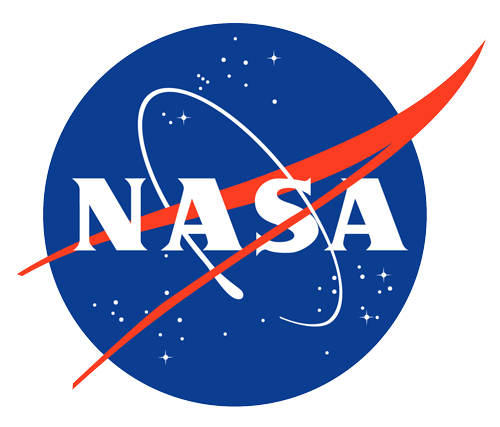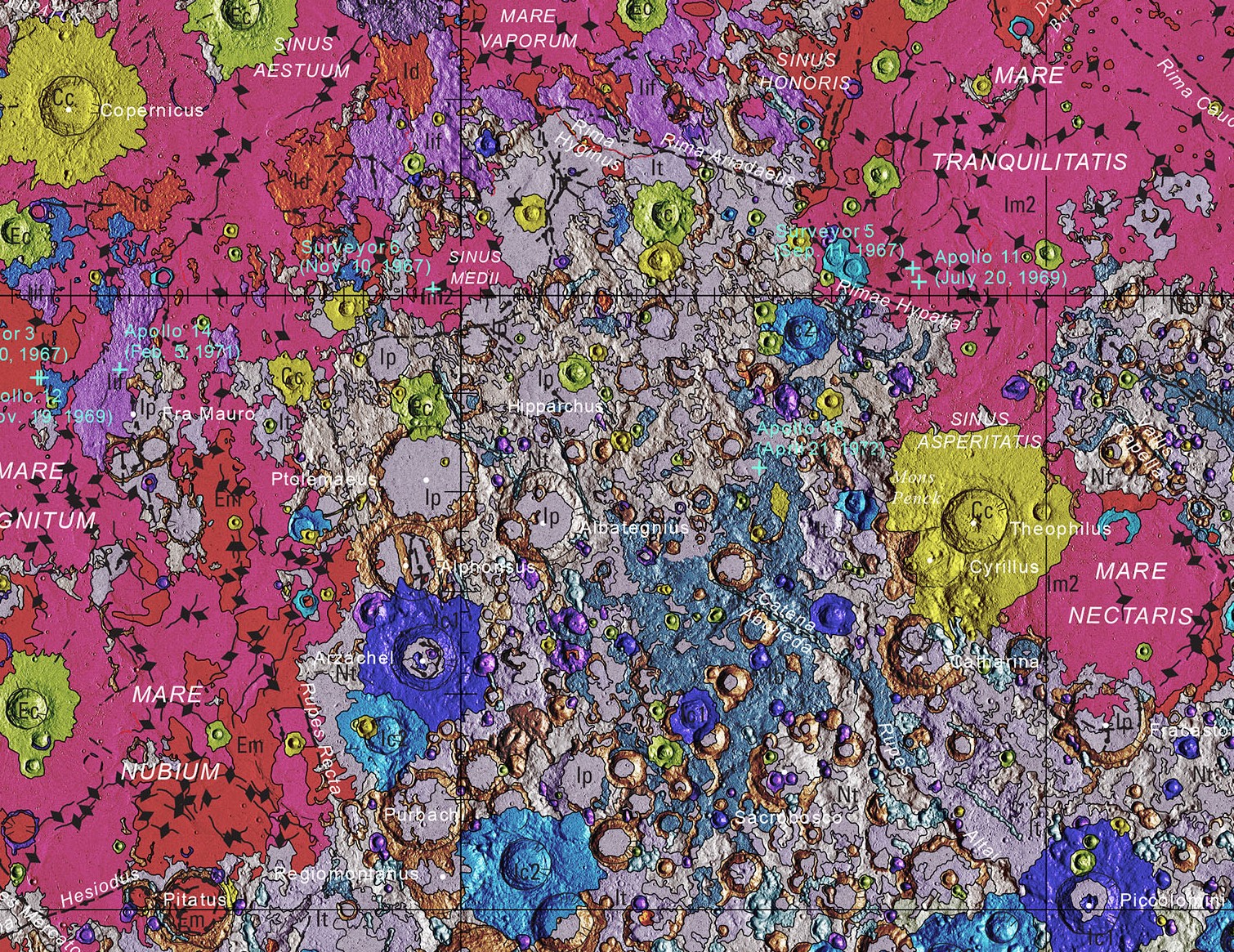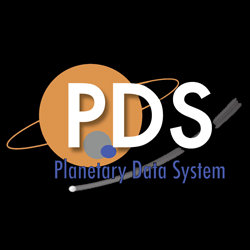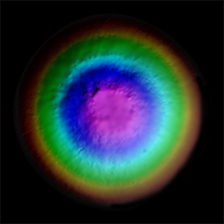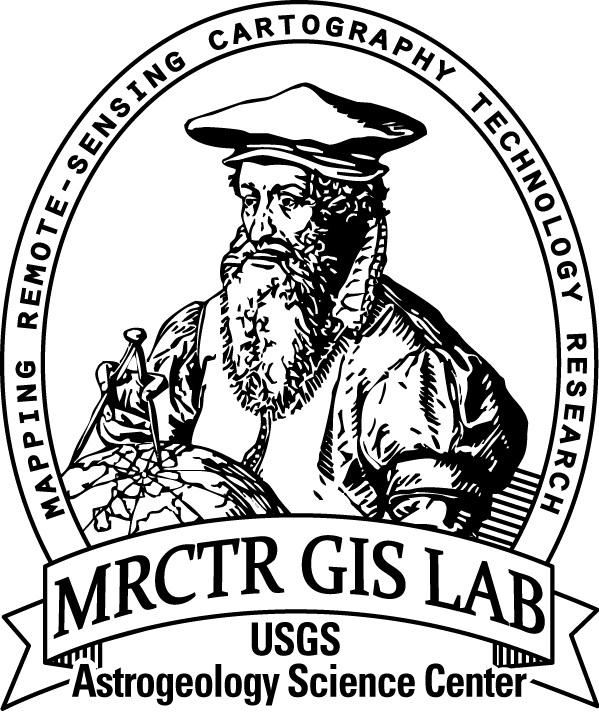Unified Geologic Map of the Moon, 1:5M, 2020
- Primary Authors
- Corey M. Fortezzo (USGS), Paul D. Spudis (LPI), Shannon L. Harrel (SD Mines)
- Originators
- USGS Astrogeology Science Center
- Publisher
- USGS Astrogeology Science Center
- Publication Date
- 2020-03-03
- Abstract
- This new work represents a seamless, globally consistent, 1:5,000,000-scale geologic map derived from the six digitally renovated geologic maps (see Source Online Linkage below). The goal of this project was to create a digital resource for science research and analysis, future geologic mapping efforts, be it local-, regional-, or global-scale products, and as a resource for the educators and the public interested in lunar geology. Here we present the completed mapping project as unit contacts, geologic unit polygons, linear features, and unit and feature nomenclature annotation. The product overlies shaded-relief products derived from SELENE Kaguya terrain camera stereo (equatorial, ~60 m/pix) and LOLA altimetry (north and south polar, 100 m/pix). These data are not included with this download due to size considerations, but a readme in the "Lunar_Raster" folder provides the download links. This download page includes a PDF of the geologic map (right-side) with a brief Description of Map Units and Explanation of Map Symbols, as well as a JPG of the map for quick access viewing. This release is subject to update based on community feedback and peer-review. Version 2 updates: Two errors were addressed in this update: (1) Large area polygons were offset from their contacts, likely due to user error. Polygons were rebuilt to fix the issue and post processing (dissolving, reattributing, etc.) to rectify the aesthetic of the map. (2) Contacts were not visible but should have been due to incorrect labeling as DND (do not draw). Those that needed to be drawn have been reattributed as "certain" those that are not drawn are labeled as "internal". Additionally, in version 1 of this data, crater polygons with similar attributes had been dissolved and lumped into contiguous units. This has been changed so that all craters are now discrete units. This adds ~1000 units to the GeoUnits feature class and the related contacts are now visible and labeled as "certain". References: Fortezzo, C.M., Spudis, P. D. and Harrel, S. L. (2020). Release of the Digital Unified Global Geologic Map of the Moon At 1:5,000,000- Scale. Paper presented at the 51st Lunar and Planetary Science Conference, Lunar and Planetary Institute, Houston, TX. https://www.hou.usra.edu/meetings/lpsc2020/pdf/2760.pdf
- Purpose
- The chief purpose of the 5M scale map is to summarize the current state of lunar geologic knowledge. Like terrestrial synoptic maps it provides a stratigraphic framework to be used for developing new theory and for determining the regional significance of surface exploration results. In addition to serving as a framework for interpreting surface exploration results, the effort to classify units into type and age by photogeology narrows the range of possible origins for many features.
Contact and Distribution
- Format
- Geologic Map
- Access Constraints
- none
- Access Scope
- MRCTR, PGM
- Use Constraints
- CC0, but please cite authors
- Edition
- 2.0, March 3, 2020
- Edition Name
- Version
- Supplemental Information
- https://www.hou.usra.edu/meetings/lpsc2020/pdf/2760.pdf
- Native Data Set Environment
- ESRI Arcinfo
- Temporal Keywords
- Copernican, Eratosthenian, Imbrian, Nectarian, Pre-Nectarian
- Mission Names
- Kaguya, Lunar Reconnaissance Orbiter
- Instrument Names
- LOLA, SELENE, TC
- Online Package Link
- https://astrogeology.usgs.gov/search/map/unified_geologic_map_of_the_moon_1_5m_2020
- External File Size
- 224413040
- Online File Link
- https://asc-astropedia.s3.us-west-2.amazonaws.com/Moon/Geology/Unified_Geologic_Map_of_the_Moon_GIS_v2.zip
- Access Instructions
-
GIS software will be required to view the files.
Image layers that are not part of the download, but used for the project include:
(1) Lola/Kaguya merged hillshade, https://astrogeology.usgs.gov/search/map/moon_lro_lola_selene_kaguya_tc_shaded_relief_merge_60n60s_59m
(2) LOLA North Pole Hillshade (100m/p, ~800Mb), https://asc-astropedia.s3.us-west-2.amazonaws.com/Moon/LMMP/LOLA-derived/ancillary/LRO_LOLA_Shade_NPole45_100m_v04.tif
(3) LOLA South Pole Hillshade (100m/p, ~800Mb), https://asc-astropedia.s3.us-west-2.amazonaws.com/Moon/LMMP/LOLA-derived/ancillary/LRO_LOLA_Shade_SPole45_100m_v04.tif
- Contact Address
- 2255 N. Gemini Drive
- Contact City
- Flagstaff
- Contact State
- AZ
- Contact Postal Code
- 86001
- Contact Email
- astroweb@usgs.gov
- Currentness Reference
- Publication date
- Progress
- Complete
- Update Frequency
- As needed
- Logical Consistency
- These maps are updated and sometimes a reinterpretation of the original geologic units or relationships.
- Completeness Report
- This release is globally produced at a 5M scale.
- Process Description
- The current renovation of the digital maps adhered to strict guidelines for vector generation and used recent datasets to spatially adjust the location of the geology and linework. The data sets discussed above were used in combination with ESRI's ArcMap Geographic Information System (GIS) software, to draw vectors on the shaded-relief derived from SELENE Kaguya terrain camera stereo (equatorial, ~60 m/pix) and LOLA altimetry (north and south polar, 100 m/pix). The vectors were drawn with a consistent vertex spacing of ~3 km at 1:1.5M scale, and were smoothed using a maximum allowable offset tolerance of ~16 km. The adjustments and adherence to these guidelines resulted in a product that increased the feature location accuracy at the 1:5M scale and makes the product more cartographically appealing.
- Source Title
- 1:5M Lunar Geologic Map Series
- Source Online Linkage
- https://astrogeology.usgs.gov/search/map/unified_geologic_map_of_the_moon_1_5m_2020
- Type of Source Media
- Online
- Attribute Accuracy Report
- Best Effort
- Horizontal Positional Accuracy Report
- Accurate to Control Net
Geospatial Information
- Target
- Moon
- System
- Earth
- Minimum Latitude
- -90
- Maximum Latitude
- 90
- Minimum Longitude
- -180
- Maximum Longitude
- 180
- Direct Spatial Reference Method
- Vector
- Object Type
- Grid Cell
- Quad Name
- Radius A
- 1737400
- Radius C
- 1737400
- Control Net
- LOLA
- Map Scale (hard-copy)
- 5000000
- Map Projection Name
- Mercator
- Latitude Type
- Planetocentric
- Longitude Direction
- Positive East
- Longitude Domain
- -180 to 180

